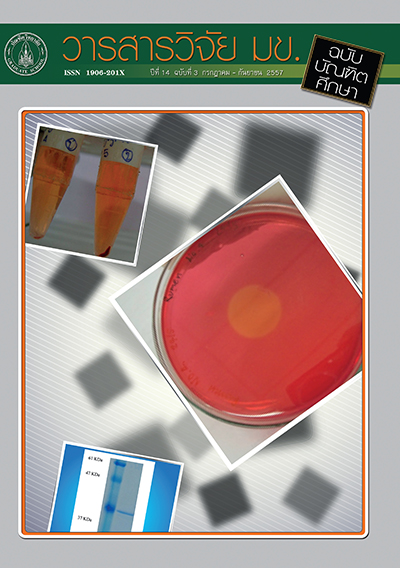Optimization of Doxorubicin Conjugation to Bacteriophages Displaying Anti-MICA for Targeted Cancer Chemotherapy
Keywords:
Targeted chemotherapy(เคมีบำบัดแบบพุ่งเป้า), Bacteriophage(แบคทีรีโรฟาจ), Doxorubicin(ดอกโซรูบิซิน), MICAAbstract
Conventional chemotherapeutic drugs in cancer therapy are distributed nonspecifically where they affect bothtumor and normal tissues lead toover dose and highly cytotoxic to normal cells. In this study, doxorubicin carryingphages targeting to major histocompatibility complex class Ichain related A (MICA) antigens was developed to improve specificity and decreasedose of cancer drug. MICA is upregulated and expressed on almost originated epithelial cancer cells which can be targeted by anti-MICA antibodies on phage particles. Doxorubicin conjugation to phage coat proteins by using 1-Ethyl-3-[3-dimethylaminopropyl] carbodiimide EDC chemistry was optimized by varying pH and different ratios of EDC and doxorubicin. Flow cytometry was brought to analyse doxorubicin on phage particle The ability of DOX-conjugated phages (DOX-Phage) to bind MICA was evaluated by ELISA. The dialysis method was performed to determine the releasing of doxorubicin from phage particles for 72 hours. The optimal pH to conjugate doxorubicin to phage particles was pH 5 with the ratio of EDC and doxorubicin of 40:1. The result from flow cytometry shown that 98.8 % ofphageparticle could be conjugated to doxorubicin After conjugation, DOX-Phage remained the binding activity against MICA antigens as shown by ELISA. The releasing amount of doxorubicin was highest at pH 5 which was 43.53 μg. In conclusion, the application of EDC chemistry is effective to conjugate doxorubicin and major coat proteins of bacteriophages without destroying binding activity of MICA antibodies. The drug releasing result indicated that doxorubicin conjugated phages should be able to release the drug at the target sites when were endocytosed into the cells but not in the circulation. Thus, DOX-carrying bacteriophages targeting MICA has been developed but further characterization will be needed regarding MICA targeting cytotoxicity of cancer cells.
การรักษาโรคมะเร็งด้วยการใช้ยาต้านมะเร็งในการแพทย์แผนปัจจุบันยังมีผลข้างเคียงต่อเนื้อเยื้อปกติและต้องใช้ยาในปริมาณมาก ในการศึกษาครั้งนี้ได้พัฒนารูปแบบตัวขนส่งยาที่จับอย่างจำเพาะกับเนื้อเยื้อมะเร็งที่เป็นเป้าหมายขึ้นเพื่อลดผลข้างเคียงที่เกิดกับเนื้อเยื้อปกติ ลดปริมาณการใช้ยาและเพิ่มประสิทธิภาพในการเข้าทำลายเซลล์เป้าหมาย โดยใช้แบคทีริโอฟาจเป็นตัวขนส่งยาไปยังเซลล์เป้าหมายที่มีการแสดงออกของ major histocompatibility complex class I chain related A (MICA) ซึ่งมีการแสดงออกเพิ่มขึ้นบนเซลล์มะเร็งโดยเฉพาะที่มีต้นกำเนิดมาจากเซลล์ผิว (epithelium) โดยติดยาต้านมะเร็งดอกโซรูบิซินเข้ากับโปรตีนของแบคทีริโอฟาจด้วยปฏิกิริยาทางเคมีโดยใช้สาร 1-Ethyl-3- [3-dimethylaminopropyl] -carbodiimide (EDC) โดยศึกษาสภาวะที่เหมาะสมด้วยการทำปฏิกิริยาในค่าพีเอชต่างๆ และปรับสัดส่วนของ EDC และยาที่ใช้ในการติด พบว่าสภาวะที่เหมาะสม คือ การทำปฏิกิริยาที่พีเอช 5 โดยใช้สัดส่วนของ EDC ต่อยา เท่ากับ 40:1 ผลโฟลไซเมทรีชี้ให้เห็นว่าแบคทีริโอฟาจสามารถติดยาดอกโซรูบิซินได้ร้อยละ 98.8 จากผลการทดสอบความสามารถในการจับกับแอนติเจน MICA โดยวิธี ELISA พบว่าแบคทีริโอฟาจที่ติดยายังสามารถจับกับแอนติเจน MICA ได้ การทดสอบการปลดปล่อยยาจากตัวแบคทีริโอฟาจโดยวิธี dialysis เป็นเวลา 72 ชั่วโมง พบว่ามีการปลดปล่อยยามากที่สุดที่ พีเอช 5 (43.53 µg) จากการศึกษาครั้งนี้สรุปว่าสามารถใช้สาร EDC ในการติดยาดอกโซรูบิซินเข้ากับโปรตีนของแบคทีริโอฟาจได้อย่างมีประสิทธิภาพและการติดยาดังกล่าวไม่ได้ทำลายความสามารถในการจับแอนติเจนของ anti-MICA นอกจากนี้ผลการศึกษาการปลดปล่อยยาชี้ให้เห็นว่าฟาจน่าจะสามารถปลดปล่อยยาได้ดีที่เซลล์เป้าหมายเมื่อเข้าสู่เซลล์ไม่ใช่ในกระแสเลือด ดังนั้นการศึกษานี้ได้พัฒนาการติดยาบนแบคทีริโอฟาจเพื่อใช้ในการในการฆ่าเซลล์มะเร็งแบบพุ่งเป้าต่อ เซลล์ที่มีการแสดงออกของ MICA อย่างไรก็ตามยังต้องมีการศึกษาเพิ่มเติม เพื่อประเมินการฆ่าเซลล์มะเร็งที่มีการแสดงออกของ MICA อย่างพุ่งเป้า



